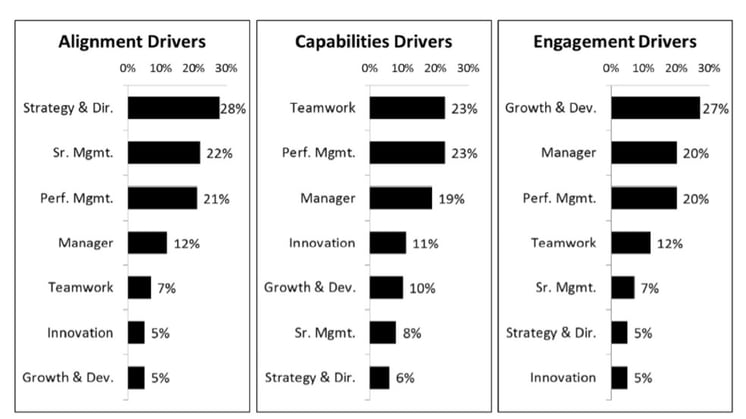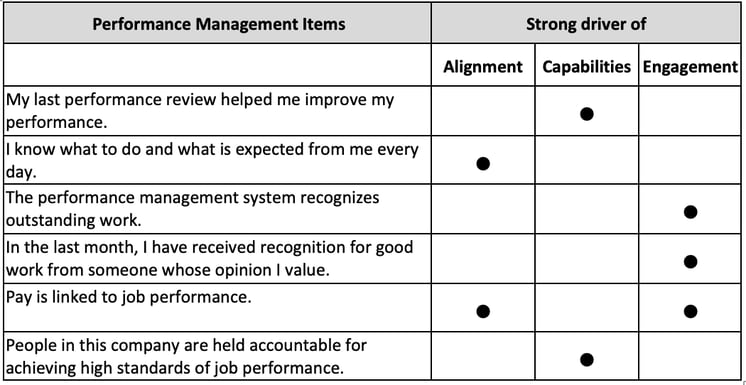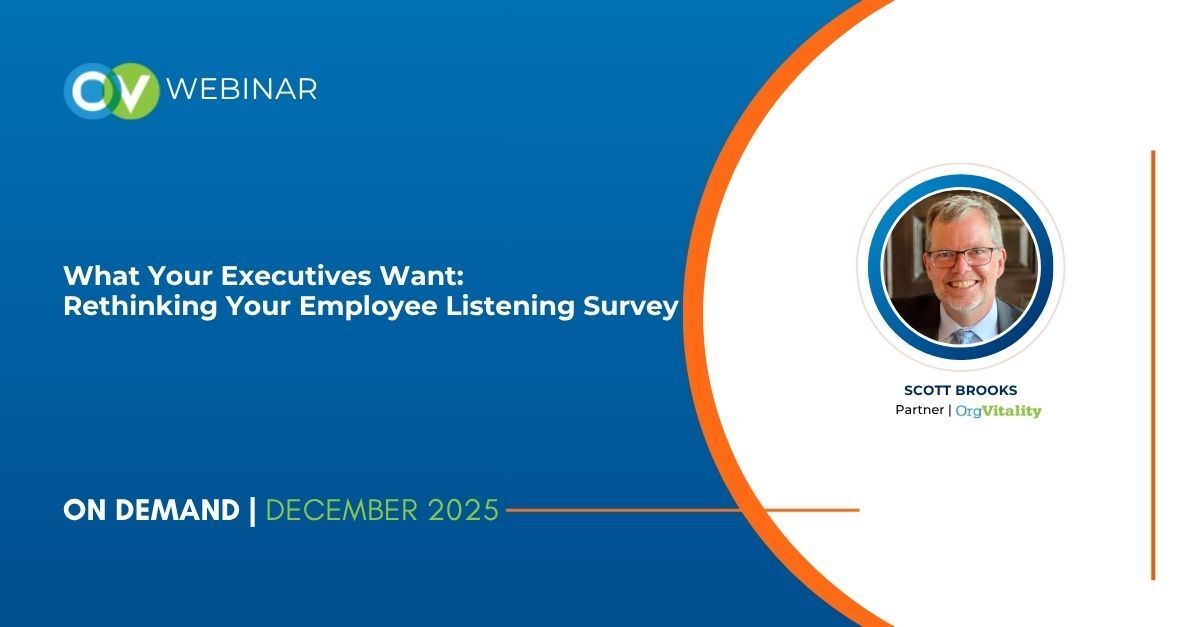
Performance management – a way for organizations to monitor and evaluate employee work – is often viewed as a necessary chore.
For managers, it can be time consuming, and uncomfortable when performance improvement is needed. Employees often worry about how they will be judged. Both sides wonder whether the whole process is really helpful, or just a waste of time. And in an era of widespread remote and hybrid work, the challenges to effective performance management have only increased. There are fewer opportunities for direct observation and less face-to-face communication.
Yet an effective performance management system can have many positive impacts beyond enhancing performance levels. Recognition, which is a key component of performance management along with employee growth and development, are frequently strong drivers of engagement. So a performance management system that successfully fosters recognition and encourages personal development should have a positive effect on engagement. In fact, we have seen very direct linkage between performance management and not just engagement, but alignment and capabilities as well.
There has been considerable research showing the relationship between employee engagement and organizational performance.
Engaged employees—those more highly connected and committed to their organization—outperform their peers on numerous measures. Our own research confirms employee engagement contributes significantly to organizational performance but is only one part of a bigger picture. Those organizations that also focus on developing the capabilities of individuals and teams, as well as creating a higher degree of alignment with organizational strategies and priorities, optimize their talent and can dramatically outpace their competition. These three factors in combination—alignment, capabilities and engagement (the ACE Framework)—give organizations a distinct advantage.
Performance management is just one dimension that can drive a high level of alignment, capabilities, and engagement, but it is one of the few drivers that can have a powerful effect on all three factors.
Figure 1 shows the results of driver analysis for a global financial services company. The relative importance, or weight, of the drivers is shown as the percentage of variance explained (“driven”) by the driver. So for example, under Engagement we see that in this company the Growth & Development driver explains 27% of overall Engagement – almost four times as much as Senior Management (7%). Improvements on Growth & Development issues will therefore have much more impact on Engagement than improvement on Senior Management issues. And while Performance Management is not the top driver for any factor, it is the only driver with a large weight on all three factors.
Figure 1. Driver importance varied by ACE factor at a global financial firm.

Diving deeper with this global financial firm, we can look within Performance Management to identify which specific items have the most impact.
In this example, different items within the Performance Management dimension are most important for A, C, and E, respectively as illustrated in Table 1. Alignment is most strongly impacted by clarity of individual responsibilities and the link between pay and performance, Capabilities is most strongly impacted by the extent to which performance reviews help employees improve their performance and by accountability, while Engagement is most strongly impacted by the extent to which the performance management system recognizes outstanding work, meaningful recognition and the pay/performance link. It is important to note that drivers can work for good or ill – an effective system will enhance ACE, while an ineffective system will diminish it.
Table 1.

Performance management systems can have complex effects on an organization. As the case we described shows, aspects of performance management will impact much more than the level of job performance.
It can boost the extent to which employees are connected to the business strategy. This includes employees’ alignment with goals, the needs of their customers, and the organization’s brand promise. It can support accountability and effectiveness, increasing capabilities. And it can grow engagement by supporting recognition. Plus, it is a two-way street because organizations with people who are aligned, have the needed capabilities, and are engaged are more effective at reaching strategic goals and at helping employees achieve their personal goals.
By creating an effective performance management system, you can improve both individual and organizational performance. The right system will inherently make sense to employees, managers, and leadership, who will understand the benefit of their performance management efforts.
How much impact can enhancing your performance management system have?
At a regional energy company, we applied the ACE Framework and found that while Engagement results were moderate, Capabilities and Alignment were very significant issues. The Alignment results validated concerns of senior management: employees did not have a clear line of sight from personal, job specific goals, to department goals and on to organizational strategy. Little more than half of the employees felt they understood the company’s goals and how it planned to reach them. Even fewer saw any link between individual goals and those company objectives. The connection between departmental and company goals was also less clear than it should have been. Much of the responsibility for communicating strategy falls to senior leaders. Not surprisingly, the survey showed the need for improvement in communication from top executives.
In preparing an enterprise-level response to improve Alignment, the company identified the performance management system as a point of leverage that could be used to influence several root causes. This would allow an integrated solution to the problem. “The performance management system was redesigned such that at each level (individual, department, division) annual goals had to include at least one objective that was directly tied to a goal at the next higher level,” according to the CHRO. This seemingly simple directive had profound repercussions.

First, in order for goals to be linked, there have to be clear, explicit objectives at each level of the organization.
So one result was greater discipline in timely goal-setting at all levels. An ancillary benefit of this was a change in perceptions of Performance Management activities from being an annual “tick the box” exercise to being a strategic activity.
Second, you can’t connect or derive your goal from the broader objectives if you do not know what those broader goals are.
Thus, another outcome was much more communication and discussion about strategy, both the company strategic plan and the role each division and department played in executing the strategy. Here, senior leadership had to perform a central role to make the strategic plan a reality for employees. As a result, awareness and understanding of how strategic responsibilities cascade through the organization increased.
Finally, the new performance management process ensured that there was in fact a connection from individual to department goals, and on up to the company strategic goals.
For some employees, this was just an illumination of a connection that had not been clear before. But in other cases, it helped identify misalignment, where effort was not being focused on the activities that most directly supported department – and company – strategy. Resource optimization resulted from the new focus on activities that would impact department, and ultimately company, performance.
Results
When the survey was repeated the next year, extraordinary gains were achieved on Alignment.
In just twelve months, the company achieved an overall 17 percentage point improvement on Alignment – more than three times the typical one-year gain. Alignment had gone from being a priority issue, to being an organizational strength.

In addition, perceptions of senior leadership became much more favorable, due to their hands-on involvement meeting with employees and explaining the strategy. Employees sensed more support for creativity and innovation, as their feedback replaced misaligned activities with more productive work.
For this company, a single point of leverage had produced truly impressive movement. “This experience shows that when you use the right tools to identify the problems, you can focus on and meet strategic goals,” said the CEO.
Armed with information obtained from a strategic ACE survey, the company was able to pinpoint gaps, identify root causes and take action that resulted in an extraordinary increase in alignment scores in just one year, with numerous positive spillover effects.

Subsequent surveys provided the ammunition needed to take action on key drivers of Capabilities and Engagement, increasing the ratings in these two areas from moderate to high over the next 2 years.
As a result, in just 3 years they were able to achieve superior scores in all three critical areas, thereby fully optimizing their workforce. Most importantly, senior leaders were able to see lasting improvements in company business performance and strategic achievement.
If you would like help measuring the connection between performance management and engagement in your organization, or want to learn more about the ACE Framework, contact Jerry Seibert directly.
This content is adapted in part from the author’s book Hidden Drivers of Success: Leveraging Employee Insights for Strategic Advantage, cowritten with Bill Schiemann & Brian Morgan.
Author

Jerry Seibert, M.A., is an executive consultant at OrgVitality. He has 30 years of experience working with organizations to measure and improve customer, employee and other stakeholder perceptions. In addition to leading a wide range of client engagements, Mr. Seibert has also led research in internal customer service and its connection to business outcomes. He has designed and implemented employee surveys for numerous organizations, ranging in scope from global entities to small privately held firms. He is the co-author of Hidden Drivers of Success: Leveraging Employee Insights for Strategic Advantage, published by SHRM in 2013, and has more than 20 publications to his credit in a variety of peer reviewed and professional journals. Mr. Seibert received his M.A. degree in Industrial/ Organizational Psychology from Western Kentucky University in Bowling Green. He has a B.A. in Psychology from the University of Delaware.






